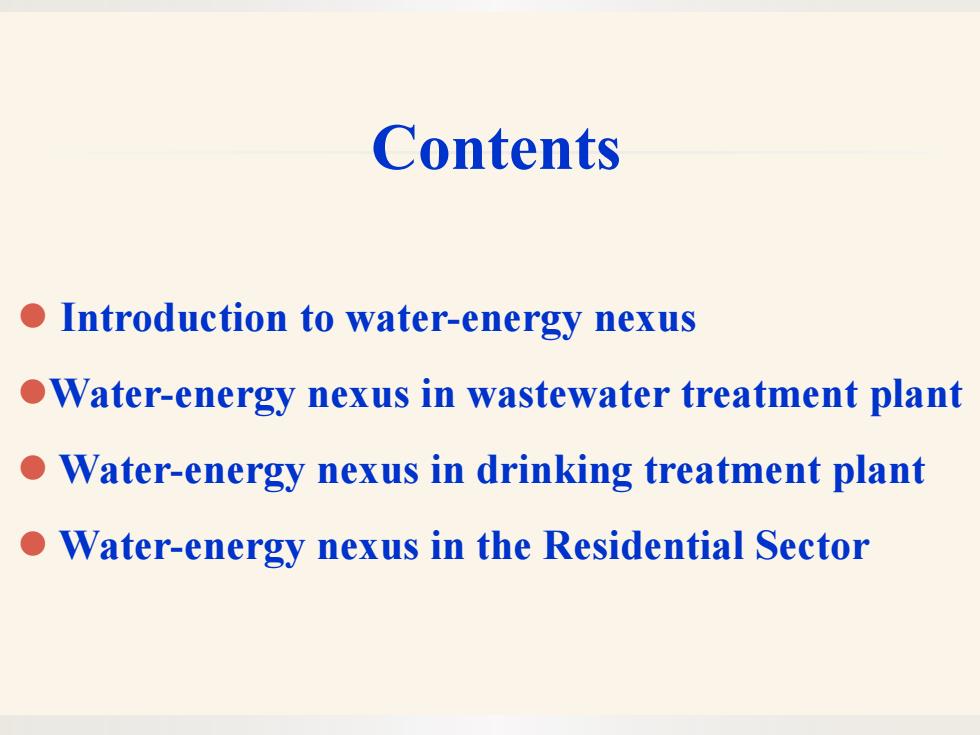
Contents oIntroduction to water-energy nexus Water-energy nexus in wastewater treatment plant Water-energy nexus in drinking treatment plant ●】 Water-energy nexus in the Residential Sector
Contents ⚫ Introduction to water-energy nexus ⚫Water-energy nexus in wastewater treatment plant ⚫ Water-energy nexus in drinking treatment plant ⚫ Water-energy nexus in the Residential Sector
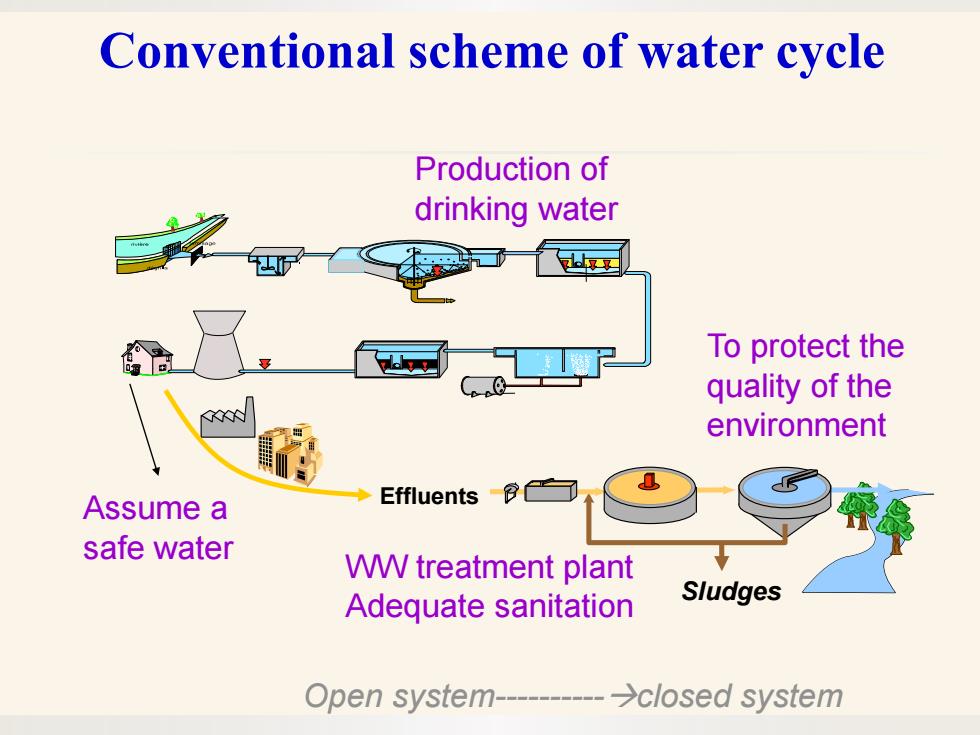
Conventional scheme of water cycle Production of drinking water To protect the quality of the environment Assume a Effluents8与 safe water W treatment plant Adequate sanitation Sludges Open system---------->closed system
Conventional scheme of water cycle Sludges Effluents WW treatment plant Adequate sanitation Production of drinking water To protect the quality of the environment Assume a safe water Open system----------→closed system
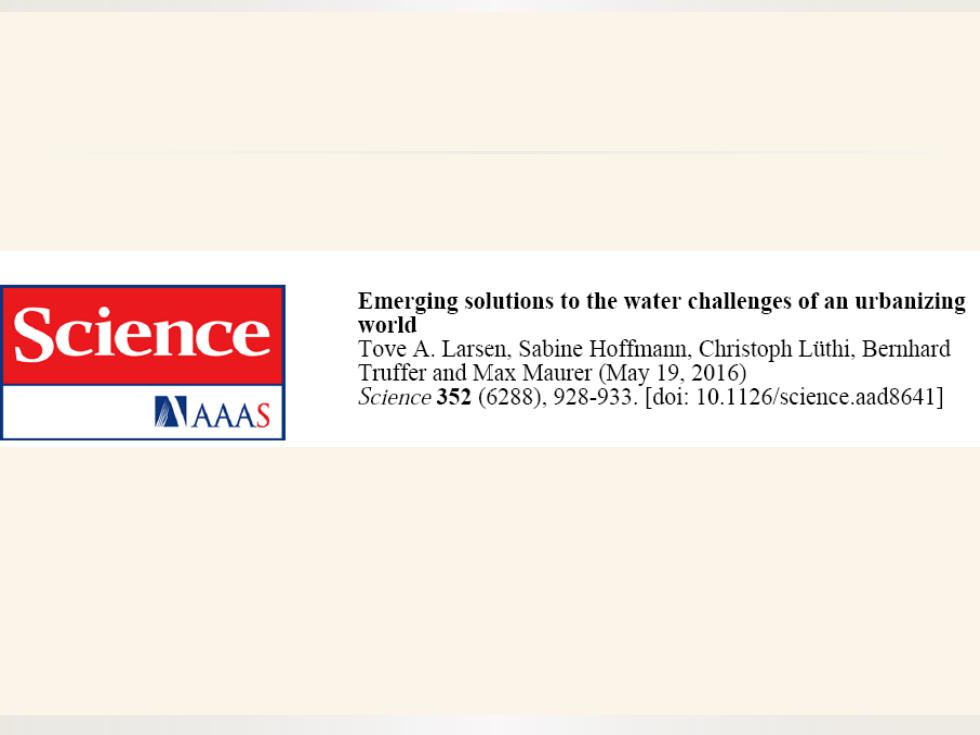
Emerging solutions to the water challenges of an urbanizing Science world Tove A.Larsen,Sabine Hoffmann,Christoph Luithi,Bernhard Truffer and Max Maurer (May 19,2016) ATAAAS Science352(6288),928-933.[doi:10.1126/science.aad8641]
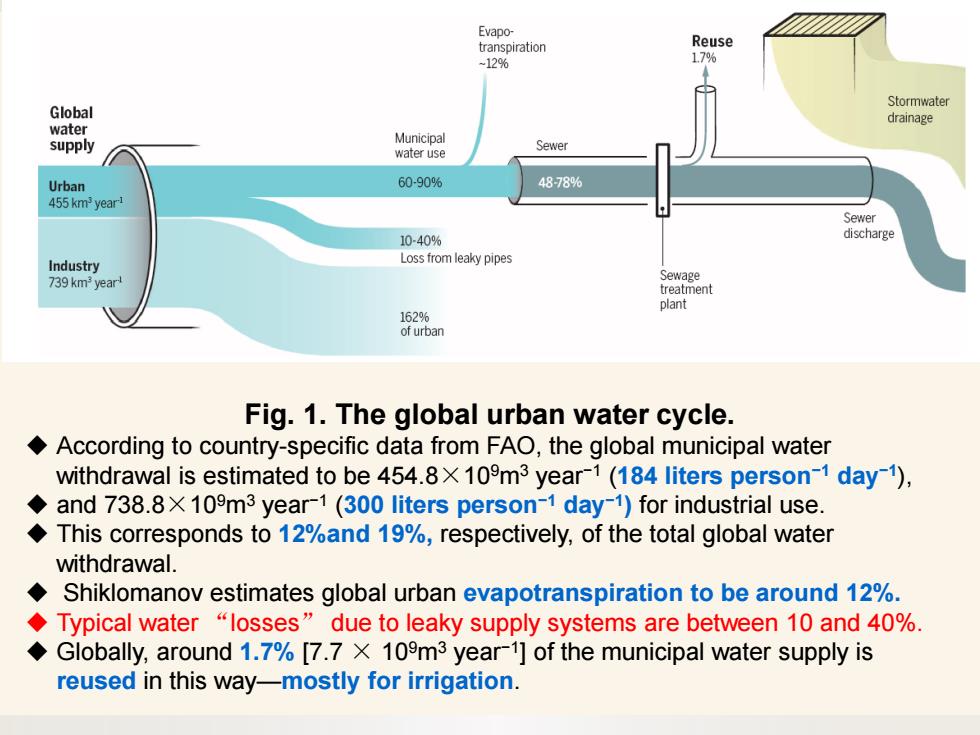
Evapo- transpiration Reuse -129% 17% Stormwater Global drainage water supply Municipal Sewer water use Urban 60-90% 4878% 455 km year Sewer 10-40% discharge Industry Loss from leaky pipes Sewage 739 km year treatment plant 162% of urban Fig.1.The global urban water cycle. According to country-specific data from FAO,the global municipal water withdrawal is estimated to be 454.8x 109m3 year-1(184 liters person-1 day-1), and 738.8X 109m3 year-1(300 liters person-1 day-1)for industrial use. This corresponds to 12%and 19%,respectively,of the total global water withdrawal. Shiklomanov estimates global urban evapotranspiration to be around 12%. Typical water "losses"due to leaky supply systems are between 10 and 40%. Globally,around 1.7%[7.7 X 109m3 year-1]of the municipal water supply is reused in this way-mostly for irrigation
Fig. 1. The global urban water cycle. ◆ According to country-specific data from FAO, the global municipal water withdrawal is estimated to be 454.8×109m3 year−1 (184 liters person−1 day−1), ◆ and 738.8×109m3 year−1 (300 liters person−1 day−1) for industrial use. ◆ This corresponds to 12%and 19%, respectively, of the total global water withdrawal. ◆ Shiklomanov estimates global urban evapotranspiration to be around 12%. ◆ Typical water “losses” due to leaky supply systems are between 10 and 40%. ◆ Globally, around 1.7% [7.7 × 109m3 year−1] of the municipal water supply is reused in this way—mostly for irrigation
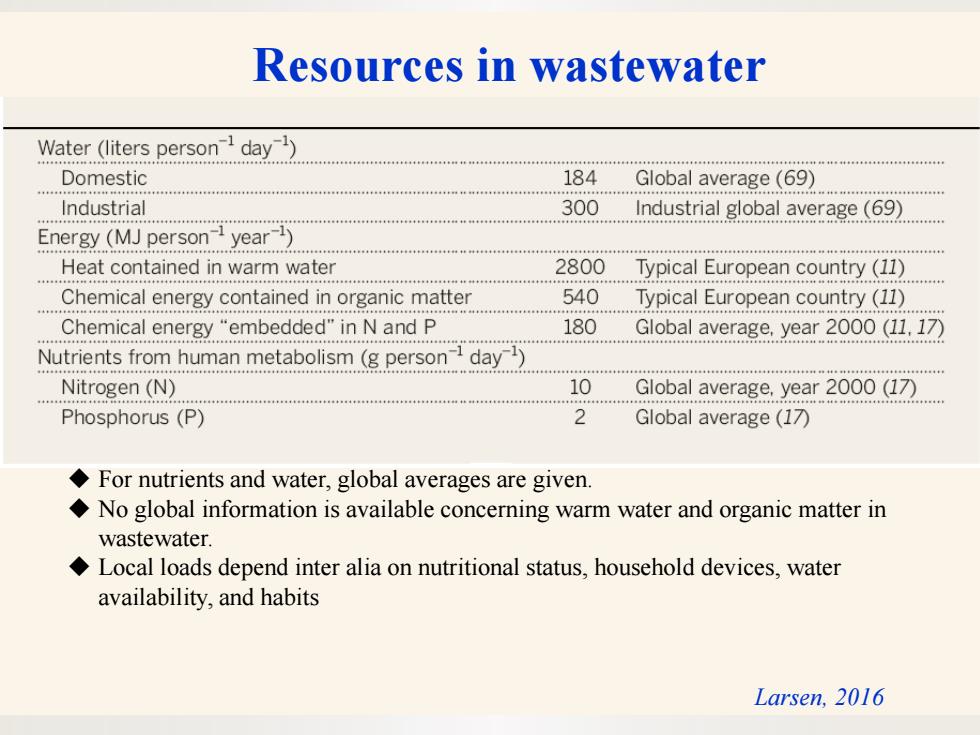
Resources in wastewater Water (liters person1 day) Domestic 184 Global average(69) Industrial 300 Energy (M)personyear) Industrial global average(69) Heat contained in warm water 2800 Typical European country(11) Chemical energy contained in organic matter 540 Typical European country (11) Chemical energy"embedded"in N and P 180 Global average,year 2000(11,17) Nutrinfrom human metabolism personday1 Nitrogen(N) 10 Global average.year 2000(17) Phosphorus (P) 2 Global average(17) For nutrients and water,global averages are given. No global information is available concerning warm water and organic matter in wastewater. Local loads depend inter alia on nutritional status,household devices,water availability,and habits Larsen,2016
Larsen, 2016 Resources in wastewater ◆ For nutrients and water, global averages are given. ◆ No global information is available concerning warm water and organic matter in wastewater. ◆ Local loads depend inter alia on nutritional status, household devices, water availability, and habits

Introduction ◆“water-energy nexus: generally defined as the interdependency between water and energy in their supply,processing,distribution,and use. Two components of water-energy nexus: “water for energy'and“energy for water.” ◆“water for energy”: water required for the extraction,processing,and transformation of energy as well as the irrigation of bioenergy There has been less agreement on the definition and system boundaries of“energy for water
Introduction ◆ “water-energy nexus: ✓ generally defined as the interdependency between water and energy in their supply, processing, distribution, and use. ◆ Two components of water-energy nexus: ✓ “water for energy” and “energy for water.” ◆ “water for energy”: ✓ water required for the extraction, processing, and transformation of energy as well as the irrigation of bioenergy ◆ There has been less agreement on the definition and system boundaries of “energy for water
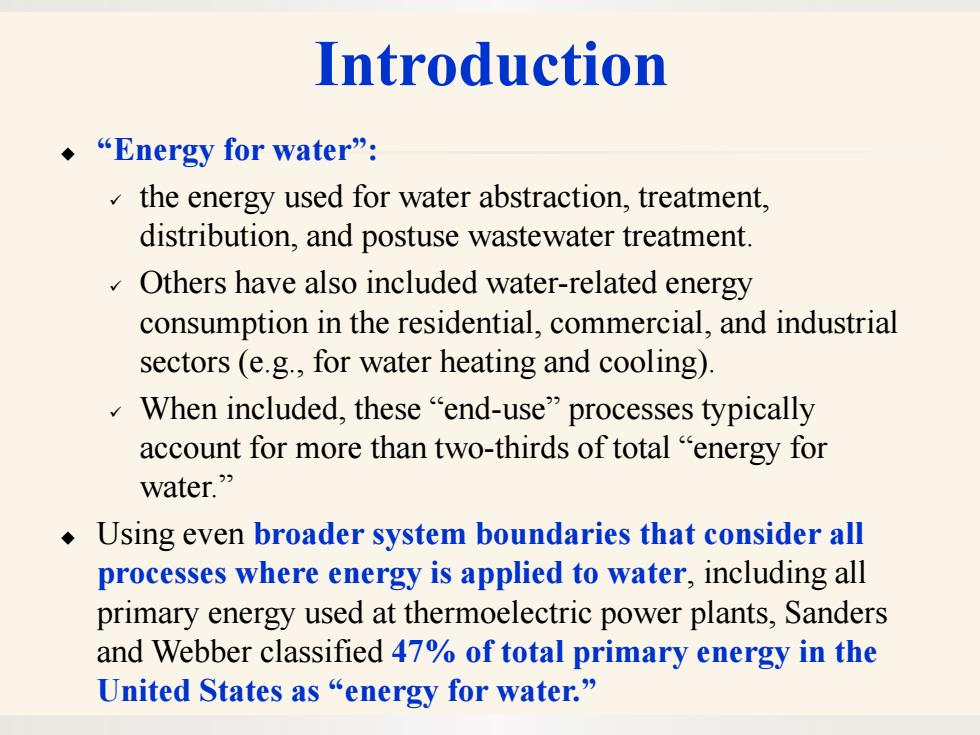
Introduction ◆“Energy for water'": the energy used for water abstraction,treatment, distribution,and postuse wastewater treatment. Others have also included water-related energy consumption in the residential,commercial,and industrial sectors (e.g.,for water heating and cooling). When included,these"end-use"processes typically account for more than two-thirds of total "energy for water." Using even broader system boundaries that consider all processes where energy is applied to water,including all primary energy used at thermoelectric power plants,Sanders and Webber classified 47%of total primary energy in the United States as“energy for water
Introduction ◆ “Energy for water”: ✓ the energy used for water abstraction, treatment, distribution, and postuse wastewater treatment. ✓ Others have also included water-related energy consumption in the residential, commercial, and industrial sectors (e.g., for water heating and cooling). ✓ When included, these “end-use” processes typically account for more than two-thirds of total “energy for water.” ◆ Using even broader system boundaries that consider all processes where energy is applied to water, including all primary energy used at thermoelectric power plants, Sanders and Webber classified 47% of total primary energy in the United States as “energy for water
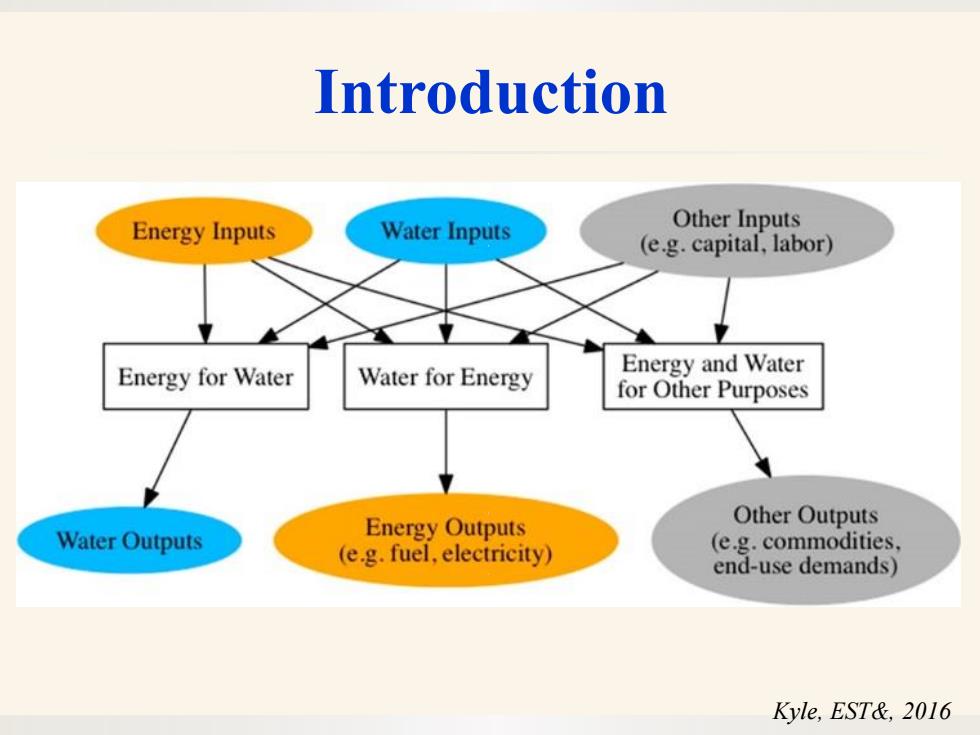
Introduction Energy Inputs Water Inputs Other Inputs (e.g.capital,labor) Energy for Water Water for Energy Energy and Water for Other Purposes Other Outputs Water Outputs Energy Outputs (e.g.fuel,electricity) (e.g.commodities, end-use demands) Kyle,EST&,2016
Kyle, EST&, 2016 Introduction

The Water-Energy Nexus Energy is used for pumping water Water used for mining fuels Water supply uses energy Enorgy used in water/wastewater treatment 0 Water Flows Water and energy use mage from"Energy Demands on Water Resources," in the home are related U.S.Department of Energy,2006(pg.13) Energy Flows

1.9EJ Global energy for water in 2010 source and conveyance 2.5EJ (4.0EJ) 0.3EJ 0.6E 1.4EJ 1.0EJ water 05E 0.9Ej 0.9EJ 1.7EJ 1.0EJ distribution (1.2EJ) 1.2EJ industry (3.1EJ ground- water (3.1EJ wastewater collection (0.2EJ 1.4EJ wastewater 1.0E』 non-fresh treatment water (1.8EJ) □surface [EJ] (1.2EJ 0.4EJ 0.9EJ ■groundwater[EJ wastewater □non-fresh water [EJ] disc ge agriculture [EJ] 0.2E0 ☐industry [EJ] ■municipal[EJ Flow of energy for water(E4W,EJ)from water sources to water processes and to water end-use sectors in 2010. Liu et al,ES&T.2016
Flow of energy for water (E4W, EJ) from water sources to water processes and to water end-use sectors in 2010. Liu et al, ES&T.2016